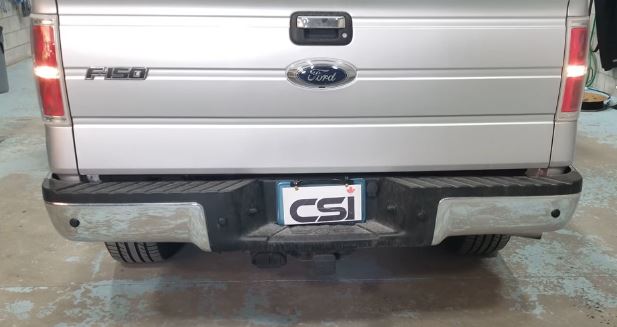Once in a while, it is justified to experience technical faults in your cars. Similarly, when you face ford backup sensors troubleshooting, it is not the time to freak out and blame the manufacturers. In contrast, it is time for some fun intellectual engagement. You gain structural knowledge of your car every time you put in a little effort to fix the minor problems by yourself. This will effectively save your time and money.
In this article, you will learn how to identify the symptoms of ford backup sensors troubleshooting. Next to test for any potential defects and to trace the core cause of symptoms. Also, by the end of this page, you will be able to troubleshoot the problem yourself. The solutions presented here are recommended, applied, and tested by experienced ford users. Let’s get started with an introduction to the ford backup sensors.
Ford Backup Sensor/Reverse Sensor

Role of Backup Sensor
The role of ford backup sensors is to warn the rider regarding the bumpers and obstacles in the direction of motion. This sensor works at the speed of 3mph, which is the casual speed while parking the car. Hence this sensor is also called a parking sensor.
There are two types of backup sensors used in automobiles.
- The ultrasonic sensors
- The electromagnetic sensors.
Working Principle
To learn about ford backup sensors troubleshooting in detail, you will need to know how the sensors in ford actually function. The working principles of both types of sensors mentioned above are distinctly different. To identify the direct symptoms of the defect, you must be thorough with the application and connectivity of the sensors.
- Ultrasonic sensor: This reflects the sound waves to warn about the nearby obstacle. Since these sensors are usually on the car surface, it suffers from many interferences and eventual system failure. The limitation of this sensor type is that, it flashes unneccesary warnings as well.
- Electromagnetic sensors: These types of sensors use electromagnetic waves to warn about the obstacles have limitations in the form of distance inaccuracy. These are located inside the bumper and does not experience interference while detecting obstacles.
No matter what type of sensor you have got on your ford model, there is a peculiar manner of warning that it gives to all riders when they come close to the obstacle. A small speaker, known as a module release audible slow-paced beeps when you approach any obstacle, and as you move closer to it, the beep paces high pitched and fast.
Since the working principle is clear, let’s jump to the first step of ford backup sensors troubleshooting.
Acknowledging the Symptoms: Step-1
- Untimely beep warning: PAM malfuctions or Disturbed connections
- No beep warning at all: Faulty PAM, Speaker or Sensor
- Constant beeping: Obstructed sensor or Car too close to ground
- Random/Unnecessary beep warning: Change in sensitivity or Accumultion of substance
Self-diagnosis: Step-2
The very first preference must be self-diagnosis of the problem before you can jump into ford backup sensors troubleshooting. However, if you have a tight schedule and cannot afford undiverted time with your car, you should hire a technician. The process requires attention and concentration. You will need to check the sensor module, the speaker, and the wire connection manually.
- Firstly, keep pressing on the parking break
- Turn on the ignition key (do not start your engine)
- Put the car in reverse mode
- Reach for the dashboard and touch to feel each sensor
If you get a sense/sound of clicking at every point, your sensor is doing just fine. Therefore, you proceed to the next inspection checking for the module, close to the main speaker in the car. You will need to remove the rubber covering to expose the wire connection underneath. Now, you can check for the defects and sort the problem as required.
Testing with AE: Alternate Step-2
- Connect the AE diagnostic tool to the car via USB connector
- Enable reading the system by accepting access request
- Add code C1704 for Right Rear Sensor Circuit Fault
- Add code C1706 for Left Rear Center Circuit Fault
- Add code C1710 for Right Rear Center Circuit Fault
Overall Ford Backup Sensors Troubleshooting: Step-3
Now that you have better clarity of the problem, you can proceed with the fixing procedure. Sometimes these problems are minor and handleable to fix manually. At some other times, you will need the guidance of an expert or have to rely on the mechanics. To start with, let’s try ford backup sensors troubleshooting manually before switching to experts.
- First of all, spray wd-40 into the sensor to remove moisture
- Refer the sensor installation guide to fix the disturbed wiring
- Clean the module from any kind of accumulation built over it
- If it still does not work, you need to change your speaker
Must Read | Sort Out 4 Worst Ford Ranger Acceleration Problems Now!
Ford Backup Sensors Troubleshooting Mechanic: Alternate Step-3
If you have already identified the symptoms accurately but do not have enough time to initiate a manual ford backup sensors troubleshooting, you can hire a mechanic. The online platforms offer you the best ford maintenance services, where you can obtain a free quotation of possible expenditure. These people will reach you and get your sensor fixed urgently, consuming the only 1/4th of the time required in manual fixing.
| Items | Price Ranges |
| Module | $200-$300 |
| Sensor | $525-$600 |
| Speaker | $20-$50 |
| Labor Cost | $90-$110 |
| Total Range | $835-$1060 |
FAQs Related to Ford Backup Sensors Troubleshooting
How do you test a backup sensor?
You can test the backup sensor by two methods. If you have the diagnostic tool, it shows the exact status of sensors as you input relevant codes, you can test professionally. But if you do not have it, then go for a manual check-up on each of the components that might be causing the problem potentially.
How to remove the backup sensor?
You will have to lay on the ground and reach for the rear bumper, find your way through the metal beam and search for the wiring system connected to the sensor. Then you will only have to pull it out from the origin plug. Push the sensor, and there you go!
Why is my backup sensor not beeping?
There can be many reasons for this problem. To trace the real cause before you go for any ford backup sensors troubleshooting, refer to this list.
(1) Check for snow, dirt, and other substantial accumulation on the sensor.
(2) Check the module is clear from magnetic accumulations.
(3) Check the wiring system is not interrupted.
(4) It might be a speaker and not a sensor problem. (re-confirm)
Final Words
You are now ready to initiate a ford backup sensors troubleshooting. Get the problem sorted when you still have time, do not let your car experience aggravated fault due to delayed response. The best thing you can do is to solve the issue as soon as the symptoms are detected. It is natural for your sensor to accumulate dirt and moisture over time. Regularly clean your car components to avoid faults in the first place.
